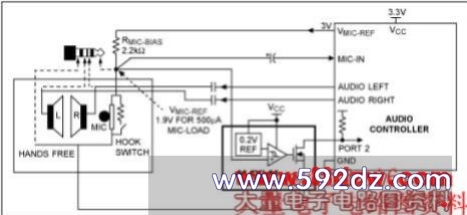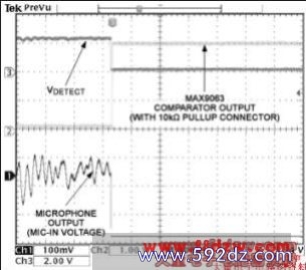Keep Power Consumption in Chec
[05-04 22:12:52] 来源:http://www.592dz.com 模拟电子技术 阅读:9997次
概要:nts. These features make it an excellent choice for headset detection in battery-operated, space- and power-sensitive applications like cell phones, portable media players, and notebook computers.Hook-Switch DetectionMost hands-free headsets include a switch, usually known as a hook switch, that accepts and ends calls; provides the MUTE/HOLD function; and holds an ongoing call while receiving a second call. The microcontroller controlling the headset needs to detect the status of the hook switch and the presence of the headset. The jack (hence
Keep Power Consumption in Chec,http://www.592dz.comThe comparator for this portable headset-detect application should be tiny and consume little power. The comparator in Figure 4 is just 1mm × 1mm and draws a maximum supply current of only 1µA. Its strong immunity to cell-phone frequencies provides highly reliable operation. The comparator also has internal hysteresis and low-input bias currents. These features make it an excellent choice for headset detection in battery-operated, space- and power-sensitive applications like cell phones, portable media players, and notebook computers.
Hook-Switch Detection
Most hands-free headsets include a switch, usually known as a hook switch, that accepts and ends calls; provides the MUTE/HOLD function; and holds an ongoing call while receiving a second call. The microcontroller controlling the headset needs to detect the status of the hook switch and the presence of the headset. The jack (hence the headset) can be detected automatically (Figure 1). A signal for the hook-switch status can also be generated. Status-detection circuitry for the hook switch comprises a 4-connecter stereo headset with microphone and a parallel hook switch (Figure 5). (A mono headset is similar, but has a 3-pin connector.) In both headset types the tip is connected to the microphone in parallel with the hook switch. As shown, the hook switch presents a low resistance when pressed, and a high microphone resistance when open. As with the headset detection explained above, an interface between the headphone-detection voltage and the CMOS inputs of the microcontroller can complicate the circuit design for microphone/hook-switch detection.
Figure 5. Hook-switch detection circuitry using the MAX9063 comparator.
The voltage VDETECT (Figure 5) is pulled close to ground when the hook switch is pressed, and interpreted as logic 0 by the microcontroller. When the hook switch is open, however, VDETECT may violate the VIH spec for the CMOS inputs. Those VDETECT inputs can vary between 1.24V and 2.78V, depending on the value of RMIC-BIAS (2.2kΩ in this case) and the type of microphone in the headset.
Thus, a direct interface between the hook switch and the controller is not possible for all microphone types. Instead, a low-power comparator can be used as in Figure 5. Here the reference level is set to detect a given type of microphone, while also indicating the status of the hook switch. The comparator output is pulled high when the hook switch is pressed, and pulled low when the switch is open. Again, the MAX9060 series of comparators provides a low-power solution for these hook-switch-detect applications.
The scope shot of Figure 6 is triggered by pressing the hook switch of a mono headset. The setup is identical to that of Figure 5, but a 2.5mm universal headset for cell phones is used for the test. The headset tip has an electret microphone with hook switch and 32Ω speaker connected to its ring. That microphone draws a constant bias current of 212µA when powered with a 3V supply through the 2.2kΩ bias resistor.
Figure 6. These waveforms are taken from an electret microphone with hook switch, controlled by a mono headset and its internal control circuitry. When the hook switch of a mono headphone is pressed, the comparator detects the shorted microphone, thereby allowing its output to be pulled to a logic high.
The DC voltage observed at VDETECT is 2.52V (Figure 6), which causes the MAX9063's output to assert low. Pressing the hook switch grounds VDETECT, allowing the output to be pulled high by an external 10kΩ pullup resistor. Thus, the MAX9063 comparator in its tiny 1mm × 1mm CSP package is well suited for detecting hook switches and accessories. The MAX9028 comparator family is also suitable for these applications.
- 最新《模拟电子技术》
- 热门《模拟电子技术》